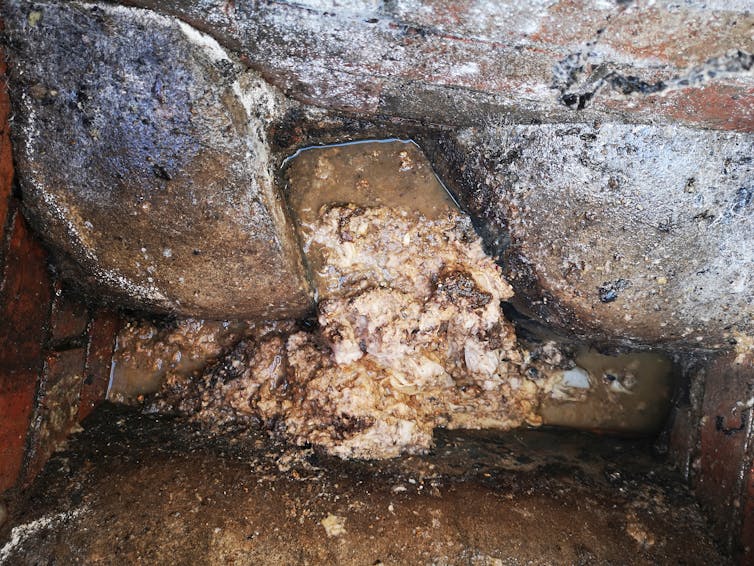William Perry, Cardiff University
The recent surge in public scrutiny over untreated sewage in waterways paints a stark picture of the UK’s ageing sewer network.
Combined sewer overflows (CSOs) are a legacy of a bygone era. Victorian combined sewers, designed to collect both sewage and surface water runoff, are buckling under the pressure. When excess rainwater overwhelms their capacity, overflows are triggered, releasing untreated sewage and rainwater directly into rivers, lakes and the sea.
While CSOs were originally intended as a solution for exceptional circumstances, their frequent activation exposes a deeper truth – the UK’s sewer system is riddled with inadequacies. A recent review by my colleagues and I found that fundamental questions surrounding CSOs remain unanswered. For example, we do not know the volume of sewage that is spilled, exactly what it contains (especially in terms of emerging contaminants), and nor do we have a comprehensive view of its impact on the health of people, ecosystems and the economy.
Based on what we do know, however, here are eight ways to overhaul the UK’s sewer system.
1. Reduce water consumption
In the 1960s, the average Briton used 85 litres of water per day. Today, that figure has jumped to 146 litres. This translates to a much larger volume of wastewater flowing into an already strained sewer system. By finding ways to prevent this extra water from entering the network in the first place, we could significantly alleviate the pressure on its capacity.
2. Capture rainwater
One readily available solution lies in harnessing the power of rainwater, by capturing it through simple devices such as water butts. This can decrease the volume of water entering the network. Captured rainwater also offers a valuable secondary benefit as a readily available, eco-friendly source of water for tasks including gardening and flushing toilets.
3. Fix misconnections
Misconnected pipes pose a hidden threat, occurring when sewage pipes are mistakenly connected to rainwater drains, diverting raw sewage directly into rivers and streams. Conversely, rainwater can also be misdirected into the sewer system, overloading its capacity. Estimates suggest that between 150,000 and half a million homes have misconnected pipes.
4. Only flush the three Ps
The only things which should be flushed down the toilet are pee, poo and paper. But strange things have been found in sewers, from adult toys to false teeth and even pet snakes.
However, it is wet wipes that contribute to 94% of sewer blockages. When combined with discarded cooking fats, they can form enormous “fatbergs” in sewers. Even so-called “flushable” wet wipes can cause considerable issues, due to the time they take to degrade. Blockages cause sewage to back-up and ultimately spill out through CSOs.

jax10289/Shutterstock
5. Use smart technology
While other utilities have embraced innovative technology, the water sector lags behind. The electricity sector has developed the smart grid – a network of sensors and software that allows for real-time monitoring and optimisation of energy use. By 2022, 31.3 million smart energy meters had been installed across the UK. In contrast, the number of smart water meters remains unknown.
Water utilities are missing out on increased efficiencies. Even standalone smart meters, not integrated into a wider smart system, can lead to a 17% reduction in water usage, compared with traditional meters. However, this strategy relies on customers’ willingness to have meters; some 40% of households in England and Wales don’t even have a basic water meter.
6. Use nature-based solutions
Achieving the UK’s net zero target by 2050 demands innovative solutions across all sectors, including the sewer system. But traditional approaches to increasing sewage capacity often rely on expanding infrastructure such as large concrete pipes, which come with a significant carbon footprint.
The construction of London’s Tideway project, a vast combined sewer, generated 768,756 tonnes of CO₂ – roughly 0.19% of the UK’s total emissions in 2022. Replicating this approach across the UK’s 77 most populous urban areas would collectively produce 14.4% of its emissions.
Fortunately, nature-based solutions offer a promising alternative. These low carbon and even carbon-sequestering approaches can effectively manage wastewater and rainwater runoff. Human-made wetlands mimic natural ecosystems to treat sewage, while rain gardens and retention ponds capture rainwater, preventing it from overwhelming the sewer system.
7. Take the C out of CSO
Unlike more modern systems, combined sewers act as a mixing bowl for a variety of water sources, collecting everything from rainwater and domestic sewage to industrial runoff. This creates a complex cocktail of potential pollutants, including hazardous chemicals, that can be difficult and expensive to treat effectively at large centralised facilities.
By separating these different sources, the treatment process could be simplified. For instance, industrial wastewater, which can be laden with heavy metals, could be diverted to specialised treatment plants equipped with advanced technologies such as ultrafiltration. This targeted approach would allow for more effective treatment of smaller volumes of wastewater, reducing the burden on the current system.
8. Decentralise
The traditional model of transporting all sewage to a central treatment plant should also be reviewed. Decentralisation could see more households using “greywater” (wastewater from showers, sinks and washing machines) for garden irrigation. At a neighbourhood level, communities could treat domestic sewage locally, potentially incorporating natural solutions such as human-made wetlands.
The combination of climate change, population growth and rising water consumption is pushing our Victorian-era sewage system to breaking point. To safeguard our waterways and build resilience for future challenges, a radical rethink is essential, and soon.

Don’t have time to read about climate change as much as you’d like?
Get a weekly roundup in your inbox instead. Every Wednesday, The Conversation’s environment editor writes Imagine, a short email that goes a little deeper into just one climate issue. Join the 30,000+ readers who’ve subscribed so far.![]()
William Perry, Postdoctoral Research Associate at the School of Biosciences, Cardiff University
This article is republished from The Conversation under a Creative Commons license. Read the original article.







